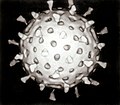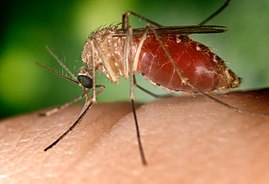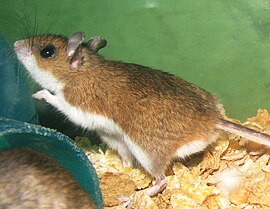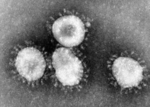Portal:Viruses
The Viruses Portal
Welcome!

Viruses are small infectious agents that can replicate only inside the living cells of an organism. Viruses infect all forms of life, including animals, plants, fungi, bacteria and archaea. They are found in almost every ecosystem on Earth and are the most abundant type of biological entity, with millions of different types, although only about 6,000 viruses have been described in detail. Some viruses cause disease in humans, and others are responsible for economically important diseases of livestock and crops.
Virus particles (known as virions) consist of genetic material, which can be either DNA or RNA, wrapped in a protein coat called the capsid; some viruses also have an outer lipid envelope. The capsid can take simple helical or icosahedral forms, or more complex structures. The average virus is about 1/100 the size of the average bacterium, and most are too small to be seen directly with an optical microscope.
The origins of viruses are unclear: some may have evolved from plasmids, others from bacteria. Viruses are sometimes considered to be a life form, because they carry genetic material, reproduce and evolve through natural selection. However they lack key characteristics (such as cell structure) that are generally considered necessary to count as life. Because they possess some but not all such qualities, viruses have been described as "organisms at the edge of life".
Selected disease
Smallpox is an eradicated infectious disease of humans caused by the Variola major and V. minor viruses. V. major causes a serious disease with a mortality rate of around 30%; V. minor is associated with much milder symptoms and mortality below 1%. The virus is mainly transmitted by the respiratory route but can also be carried on contaminated objects. Smallpox preferentially infects skin cells, resulting in a usually maculopapular rash, and later, raised fluid-filled blisters. Most V. major survivors have permanent scarring, commonly on the face, which can be extensive. Less common long-term complications include blindness resulting from corneal ulceration and scarring, and in young children, limb deformities due to arthritis and osteomyelitis.
Smallpox probably emerged in human populations in about 10,000 BC; the mummified body of Egyptian pharaoh Ramses V shows evidence of smallpox rash. The disease was responsible for an estimated 300–500 million deaths during the 20th century. Smallpox vaccine, the earliest vaccine, was developed in the 18th century. After intensive vaccination campaigns, the last natural infection occurred in 1977. Smallpox was certified the first infectious disease to be eradicated globally in 1979. Debate is ongoing over whether all stocks of the virus should be destroyed.
Selected image
The antiviral fomivirsen was the first antisense therapy to be licensed by the FDA. It binds to a cytomegalovirus mRNA and is used to treat cytomegalovirus retinitis.
Credit: Fvasconcellos (1 January 2007)
In the news
26 February: In the ongoing pandemic of severe acute respiratory syndrome coronavirus 2 (SARS-CoV-2), more than 110 million confirmed cases, including 2.5 million deaths, have been documented globally since the outbreak began in December 2019. WHO
18 February: Seven asymptomatic cases of avian influenza A subtype H5N8, the first documented H5N8 cases in humans, are reported in Astrakhan Oblast, Russia, after more than 100,0000 hens died on a poultry farm in December. WHO
14 February: Seven cases of Ebola virus disease are reported in Gouécké, south-east Guinea. WHO
7 February: A case of Ebola virus disease is detected in North Kivu Province of the Democratic Republic of the Congo. WHO
4 February: An outbreak of Rift Valley fever is ongoing in Kenya, with 32 human cases, including 11 deaths, since the outbreak started in November. WHO
21 November: The US Food and Drug Administration (FDA) gives emergency-use authorisation to casirivimab/imdevimab, a combination monoclonal antibody (mAb) therapy for non-hospitalised people twelve years and over with mild-to-moderate COVID-19, after granting emergency-use authorisation to the single mAb bamlanivimab earlier in the month. FDA 1, 2
18 November: The outbreak of Ebola virus disease in Équateur Province, Democratic Republic of the Congo, which started in June, has been declared over; a total of 130 cases were recorded, with 55 deaths. UN
Selected article
Infectious diseases are symptomatic diseases of an individual host resulting from the infection and replication of pathogens, including viruses, prions, bacteria, fungi, protozoa and multicellular parasites. Infectious diseases were responsible for 17% of human deaths globally in 2013, with HIV, measles and influenza being among the most significant viral causes of death.
Infectious pathogens must enter, survive and multiply within the host, and spread to fresh hosts. Relatively few microorganisms cause disease in healthy individuals, and infectious disease results from the interplay between these rare pathogens and the host's defences. Infection does not usually result in the host's death. The pathogen is generally cleared from the body by the host's immune system, although persistent infection occurs with several viruses. Transmission can occur by physical contact, contaminated food, water or objects, body fluids, airborne inhalation or via vectors, such as the mosquito (pictured). Diagnosis sometimes involves identifying the pathogen; techniques include culture, microscopy, immunoassays and PCR-based diagnostics.
Selected outbreak
The 1993 hantavirus outbreak in the Four Corners region of southwest USA was of a novel hantavirus, subsequently named Sin Nombre virus. It caused the previously unrecognised hantavirus pulmonary syndrome – the first time that a hantavirus had been associated with respiratory symptoms. Mild flu-like symptoms were followed by the sudden onset of pulmonary oedema, which was fatal in half of those affected. A total of 24 cases were reported in April–May 1993, with many of those affected being from the Navajo Nation territory. Hantavirus infection of humans generally occurs by inhaling aerosolised urine and faeces of rodents, in this case the deer mouse (Peromyscus; pictured).
Previously documented hantavirus disease had been confined to Asia and Europe, and these were the first human cases to be recognised in the USA. Subsequent investigation revealed undiagnosed cases dating back to 1959, and Navajo people recalled similar outbreaks in 1918, 1933 and 1934.
Selected quotation
| “ | To help conceptualize the sheer number of viruses in existence, their current biomass has been estimated to equal that of 75 million blue whales (approximately 200 million tonnes) and, if placed end to end, the collective length of their virions would span 65 galaxies. | ” |
—Peter Simmonds
Recommended articles
Viruses & Subviral agents: bat virome • elephant endotheliotropic herpesvirus • HIV • introduction to viruses • Playa de Oro virus • poliovirus • prion • rotavirus
• virus
Diseases: colony collapse disorder • common cold • croup • dengue fever • gastroenteritis • Guillain–Barré syndrome • hepatitis B • hepatitis C • hepatitis E • herpes simplex • HIV/AIDS • influenza
• meningitis
• myxomatosis • polio
• pneumonia • shingles • smallpox
Epidemiology & Interventions: 2007 Bernard Matthews H5N1 outbreak • Coalition for Epidemic Preparedness Innovations • Disease X • 2009 flu pandemic • HIV/AIDS in Malawi • polio vaccine • Spanish flu • West African Ebola virus epidemic
Virus–Host interactions: antibody • host • immune system • parasitism • RNA interference
Methodology: metagenomics
Social & Media: And the Band Played On • Contagion • "Flu Season" • Frank's Cock • Race Against Time: Searching for Hope in AIDS-Ravaged Africa
• social history of viruses
• "Steve Burdick" • "The Time Is Now" • "What Lies Below"
People: Brownie Mary • Macfarlane Burnet • Bobbi Campbell • Aniru Conteh • people with hepatitis C
• HIV-positive people
• Bette Korber • Henrietta Lacks • Linda Laubenstein • Barbara McClintock
• poliomyelitis survivors
• Joseph Sonnabend • Eli Todd • Ryan White
Selected virus
Rotavirus is a genus of double-stranded RNA viruses in the family Reoviridae. There are nine species A–I; rotavirus A, the most common, causes over 90% of infections in humans. Rotavirus also infects animals, including livestock. The virus is transmitted by the faecal–oral route, with fewer than 100 virus particles being required for infection. Rotaviruses are stable in the environment and normal sanitary measures fail to protect against them. Effective rotavirus vaccines are the main prevention method.
The virus infects and damages the enterocytes lining the small intestine, causing gastroenteritis (sometimes referred to as "stomach flu," although the virus is not related to influenza). A viral toxin, NSP4, is responsible for some of the pathology. Rotavirus is the most common cause of diarrhoea among infants and young children. Almost every child worldwide has been infected with rotavirus at least once by the age of five. In 2013, 215,000 children under five died from rotavirus infection, mostly in developing countries, and almost two million more become severely ill. Immunity develops with each infection and adults are rarely affected.
Did you know?
- ...that George Hirst was the first person to discover a viral enzyme (pictured)?
- ...that fish diseases and parasites can result in mass fish die offs?
- ...that adjuvants are sometimes used to modify the effects that a vaccine has on disease resistance by stimulating the immune system to respond to the vaccine with much more vitality?
- ...that Australian ophthalmologist Sir Norman McAlister Gregg discovered the link between rubella and congenital disorders in newborn infants after overhearing several of his patients discussing their illness during pregnancy?
- ...that the very first news article on what became known as AIDS appeared in the New York Native, a now defunct gay newspaper in New York City?
Selected biography
Edward Jenner (1749–1823) was an English physician and scientist who pioneered the smallpox vaccine, the world's first vaccine. Noting the common observation that milkmaids were generally immune to smallpox, Jenner postulated that the pus in the blisters that milkmaids received from cowpox (a similar but much less virulent disease) protected them from smallpox. In 1796, Jenner tested his hypothesis by inoculating an eight-year-old boy with pus from an infected milkmaid. He subsequently repeatedly challenged the boy with variolous material, then the standard method of immunisation, without inducing disease. He published a paper including 23 cases in 1798. Although several others had previously inoculated subjects with cowpox, Jenner was the first to show that the procedure induced immunity to smallpox. He later successfully popularised cowpox vaccination.
Jenner is often called "the father of immunology", and his work is said to have saved more lives than that of any other individual.
In this month
7 November 1991: Magic Johnson announced his retirement from basketball because of his infection with HIV
14 November 1957: Kuru, the first human prion disease, described by Daniel Gajdusek and Vincent Zigas
16 November 2002: The first case of severe acute respiratory syndrome (virus pictured) recorded in Guangdong, China
17 November 1995: Lamivudine approved for treatment of HIV
22 November 2013: Simeprevir approved for treatment of chronic hepatitis C virus infection
23 November 1978: Structure of tomato bushy stunt virus solved by Stephen Harrison and colleagues, the first atomic-level structure of a virus
24 November 2007: Outbreak of new Ebola species, Bundibugyo virus
26 November 1898: Martinus Beijerinck coined the term contagium vivum fluidum to describe the agent causing tobacco mosaic disease
Selected intervention
Oseltamivir (also Tamiflu) is an oral antiviral drug against influenza (flu). It was the second inhibitor of the viral neuraminidase to be developed, after zanamivir, and the first to be taken as an oral tablet. It was originally synthesised from shikimic acid extracted from the star anise plant. Oseltamivir is a prodrug that requires metabolism in the liver to the active form, oseltamivir carboxylate. This binds at the active site of the neuraminidase enzyme, preventing it from cleaving sialic acid to release the virus particle from the host cell. Oseltamivir can reduce the duration of influenza symptoms by 0.5–1 days. Debate is ongoing about whether it also reduces the risk of complications, such as pneumonia. Nausea and vomiting are the main adverse events. Resistance to oseltamivir has been observed in some strains of influenza virus, especially H1N1 strains.
Subcategories
Subcategories of virology:
Topics
Things to do
- Comment on what you like and dislike about this portal
- Join the Viruses WikiProject
- Tag articles on viruses and virology with the project banner by adding {{WikiProject Viruses}} to the talk page
- Assess unassessed articles against the project standards
- Create requested pages: red-linked viruses | red-linked virus genera
- Expand a virus stub into a full article, adding images, citations, references and taxoboxes, following the project guidelines
- Create a new article (or expand an old one 5-fold) and nominate it for the main page Did You Know? section
- Improve a B-class article and nominate it for Good Article
or Featured Article
status
- Suggest articles, pictures, interesting facts, events and news to be featured here on the portal
WikiProjects & Portals
 WikiProject Viruses
Related WikiProjects
WikiProject Viruses
Related WikiProjects
Medicine • Microbiology • Molecular & Cellular Biology • Veterinary Medicine
Related PortalsAssociated Wikimedia
The following Wikimedia Foundation sister projects provide more on this subject:
-
Commons
Free media repository -
Wikibooks
Free textbooks and manuals -
Wikidata
Free knowledge base -
Wikinews
Free-content news -
Wikiquote
Collection of quotations -
Wikisource
Free-content library -
Wikispecies
Directory of species -
Wikiversity
Free learning tools -
Wiktionary
Dictionary and thesaurus


















